
Full text loading...
We use cookies to track usage and preferences.I Understand
This comprehensive exploration delves into the multifaceted attributes of quercetin, a flavonoid with extensive health-promoting potential. The review navigates through its fundamental properties, encompassing its chemical structure, classification as a flavonoid, and its natural prevalence in various sources. Addressing solubility, stability, and bioavailability challenges, the investigation delves into innovative isolation techniques, including solvent extraction, solid-phase extraction, natural deep eutectic solvents, supercritical fluid extraction, microwave-assisted extraction, column chromatography, and high-performance thin-layer chromatography. Transitioning into pharmacological implications, the study unveils quercetin's roles in anti-inflammatory pathways, antioxidant effects, and immune modulation, reflecting its versatile significance in health management. The review highlights its impact on wound healing processes and its potential to mitigate arthritis, elucidating its holistic contributions. Culminating in an exploration of recent studies, the analysis underscores quercetin's remarkable anti-inflammatory and anti-arthritis activities, reflecting its substantial potential across various ailments. The review concludes by projecting future trajectories, emphasizing prospects for an advanced understanding of quercetin's mechanisms, sustainable extraction techniques, clinical integration, and exploration of synergistic combinations. Collectively, this review investigation underscores quercetin's dynamic role at the intersection of natural compounds and medicinal applications, offering profound implications for well-being and health enhancement.

Article metrics loading...

Full text loading...
References


Data & Media loading...

